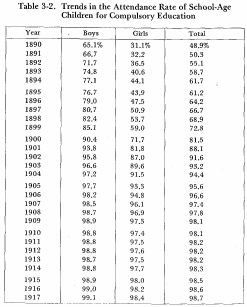- 現在位置
- トップ > 白書・統計・出版物 > 白書 > JAPAN'S MODERN EDUCATIONAL SYSTEM > a. The Abolition of Tuition and the Clarification of Rules for Compulsory Attendance
a. The Abolition of Tuition and the Clarification of Rules for Compulsory Attendance
The 1900 Elementary School Order was promulgated following the Sino-Japanese War at a time when there was a very positive popular attitude to education. The attendance rate of school-age children for compulsory education had gradually risen during the 1890s, and the 1900 Elementary School Order spelled out even more clearly than before regulations concerning compulsory attendance. The government attempted to make use of the prevailing interest in education by initiating a crash program to increase the attendance rate, and as a result universal elementary education was virtually realized.
The meaning of "school age" was made clear in Article 32 of the 1900 Elementary School Order, which defined it as "the eight years from the month after the children reach six years of age until they are full fourteen years old." The beginning and ending periods for compulsory attendance were specified by saying, "The beginning of the period for compulsory attendance commences at the beginning of the school year which comes on and after the month when the children first reach the school age and the end of the period for compulsory attendance is when they complete the ordinary elementary school course." Secondly, it was stated that "the persons looking after school-age children have the obligation of sending those children to school from the beginning of the compulsory attendance period until the end of that period." The meaning of "persons looking after school-age children," a phrase which was first used in the 1890 Elementary School Order was also clarified by saying, "The persons looking after school-age children are those persons who exercise the rights of the parents with respect to those children. In the absence of the parents, it is the guardians of those children." In addition, provisions for excusing compulsory attendance due to mental or physical disability and provisions for postponing compulsory attendance from sickness or retardation were separately elaborated, and for the first time it was clearly stated that child labor was not an acceptable excuse for skipping compulsory education. In these specifications it is easy to recognize that the government took a firm attitude with respect to compulsory education.
Table 3-2. Trends in the Attendance Rate of School-Age Children for Compulsory Education

Another important development was the elimination of tuition at city, town, and village ordinary elementary schools. Through the nineties the collection of tuition had been a fundamental provision, and as a reflection of the financial circumstances of local governments in those days the level of tuition had been steadily increased. Indeed the high tuitions became the chief factor in limiting the compulsory attendance rate, and thus educators were anxious to see an abolition of tuition and increased subsidies for compulsory education from the National Treasury. Finally, in Article 57 of the 1900 Elementary School Order it was provided that "tuition may not be collected in the case of city, town, and village ordinary elementary schools." Moreover, if due to special circumstances there was reason to collect tuition, the permission of the governor of the prefecture had to be obtained.
お問合せ先
(C)COPYRIGHT Ministry of Education, Culture, Sports, Science and Technology
-- 登録:平成21年以前 --